Diamond Cut
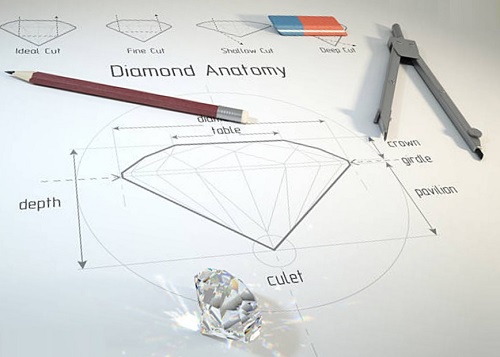
Diamond cut is the most important aspect of the 4Cs when buying a diamond. It determines the amount of sparkle and fire that a diamond will display.
So, if you want to know how to select a beautiful looking diamond instead of a dull looking one, you’ve come to the right place!
In this section, you are going to find out what is diamond cut and why it matters when you are shopping for an engagement ring. You are also going to get the real insights to selecting well-cut diamonds and how to separate the wheat from the chaff.
Let’s get started…
What is Diamond Cut?
In essence, cut refers to how well a diamond’s facets interact with light. A well cut diamond will display superior brightness, fire and scintillation compared to one that is poorly cut.
There are 3 main attributes that affect the diamond’s overall cut quality. They are:
- Proportions: The angles and relative measurements of a polished diamond.
- Symmetry: The precision of a finished diamond’s shape and facet placements.
- Polish: The overall condition of the diamond’s facets surfaces.
Many people often confuse cut to be the same as a diamond’s shape. They aren’t the same thing and it doesn’t help that many jewelers use these 2 terms interchangeably.
Strictly speaking, shape refers to the outline a diamond has (e.g. heart and cushion) while cut refers to a combined aspect of a diamond’s proportions and finishing (symmetry/polish).
Why Cut is Always KING?
Cut itself can make a diamond look bigger, improve the face up color and help mask inclusions. This means you effectively get a “free” boost in the other aspects of the 3Cs (color, carat and clarity) just by having a better cut!
Check out the comparison of a perfectly cut diamond and an inferior cut diamond below. The one on the left has superb scintillation patterning and very strong light return while the diamond on the right is less lively and displays a messy contrast patterning.
I want you to click on the images to see the differences between the 2 diamonds for yourself.
The visual difference between a truly well-cut diamond and a poorly cut diamond is huge!
The thing is, a well cut diamond will have better proportions that don’t cause excessive carat weight to be hidden in its side profile. This makes the diamond appear the right size for its weight compared to another diamond that is cut deeply and faces up smaller.
Having better light return will make the diamond face up whiter since more light is reflected back into the eyes of the viewer. Lastly, well cut diamonds will display an intense scintillation and fire which can help hide inclusions under its sparkle.
What Does a Well Cut Diamond Look Like in Real Life?
Check out the following video of an I color SI1 diamond engagement ring. This diamond was personally handpicked for the best cut and sparkle. It will give you an idea of what a truly well-cut diamond looks like in real-life.
How Light Transverses Diamonds With Different Cut Properties
Did you know that the amazing play of light displayed by a diamond is actually governed by the laws of physics?
On a fundamental level, the amount of sparkle and scintillation is dependent on how light rays are refracted and reflected within the diamond. This is why the precise positioning and alignment of each facet matters as they act like tiny mirrors to interact with light.
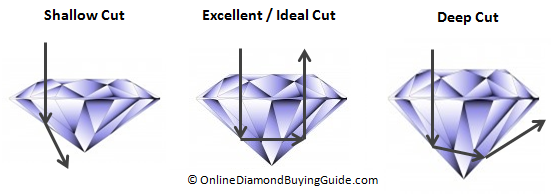
In a well cut stone, a large percentage of light that enters the diamond gets reflected back into the viewer’s eyes. This gives the diamond a bright looking appearance and enhances its luster.
With less ideal diamond cut quality, light is lost through the sides of the diamond instead of being reflected back into the viewer’s eyes. This translates to a less brilliant and darker appearance of the diamond.
Making Sense of Diamond Cut Grading – A Quick Overview
A gemological lab like GIA typically performs diamond cut grading by reviewing a range of parameters like the diamond’s proportions, polish/symmetry ratings, cutlet size and girdle thickness.
Watch the short video below to get a quick overview into this topic.
In a typical grading report for a round brilliant diamond, you can find a similar diagram like the example below. On this diagram, the averaged measurements of the corresponding facets are indicated.
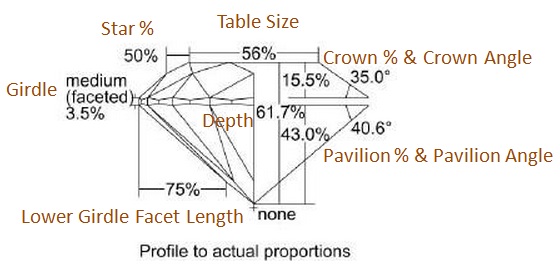
Depending on how technical (or hardcore) you want to be, you can analyze each of these parameters and study the correlations between them. I will talk about it in advanced tutorials found on the later pages.
Now, I know most people get scared or turned off when they see a technical diagram like this. As a consumer, an easier alternative would be to simply use the GIA/AGS cut grading as a filter to pre-screen round diamonds.
For the record, I only recommend buying a round diamond with a GIA triple excellent cut grade or an AGS ideal cut grade.
Gemological labs like GIA or AGS take the proportion variations of a diamond into account when assessing a diamond’s cut grade. If any particular aspect of the cut proportions has an issue, the diamond will be downgraded and assigned with a lower cut grade accordingly.
That means even if you blindly go along with any GIA triple excellent diamond, it is unlikely for you to end up with an ugly looking stone. However, if you want to select the cream of the crop among the GIA triple excellent stones, you will need to do some extra work in filtering your choices.
But first, I want to show you the visual appearances of the various diamond cut grades using real-life examples. You will get to interact with video listings and see how they look like up-close. Head onto the next page and continue reading…
Related Articles
Leave A Comment

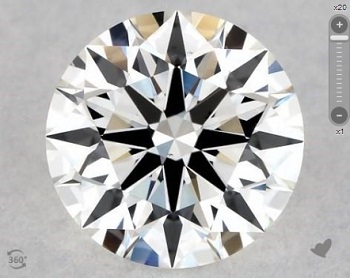
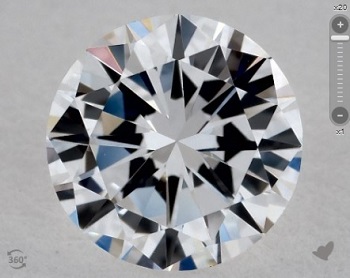
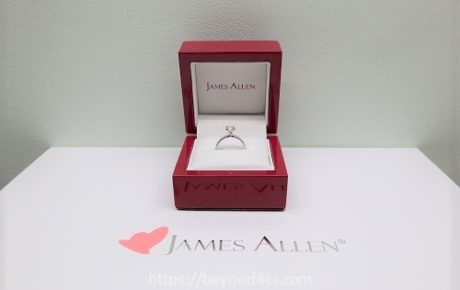
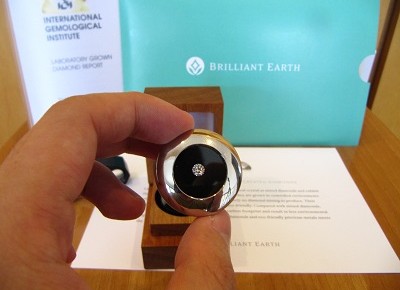
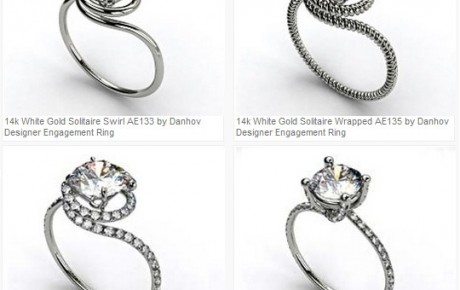
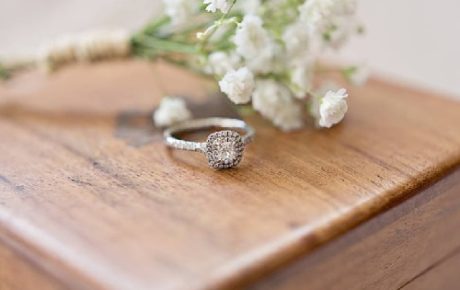









43 Comments
Hi Paul,
1. What is your comment on Lights Performance Certification; for example Gemex and Sarin? Isn’t it now important to evaluate best cut diamond in advance/modern ways?
2. With advancing technology of diamond cutting, don’t you agree that diamonds with more facets are better compared to the traditional 57/58 facets? (with the assurance that the light performance is excellent, of course!)
1) Gemex is a sales tool for jewelers and the equipment is expensive to purchase. By the way, Gemex is not an advanced technology per se. It’s been around for some time now. In contrast, the ASET does a better role of discerning precision cutting better than the Gemex and is more useful when it comes to evaluating light return critically.
The Sarin has been used in almost all major labs (it still is) during the grading process because of its accuracy and speed.
2) It depends. A modified round diamond cut creates a different flavor to the stone’s appearance. Assuming that the light return of the diamond is excellent, then it boils down to personal preferences to decide if the cut is “better”.
https://beyond4cs.com/shapes/round/solasfera-vs-star-129/
Hi Paul, I found your website. Interesting read. Can’t help but to ask based on Zam’s comments. Is it better to purchase diamonds which has a light performance certificate or based on a diamond cut chart? What’s the difference between ideal vs excellent? Which is the best diamond cut for sparkle? And why some jewelers do not have light performance certificate on their listings?
Many thanks!
If light performance reports are readily made available, I would say yes. It does help to have as much information as possible when buying a diamond. Reports like Gemex are good to have but not mandatory. Also, you shouldn’t buy diamonds that only have a Gemex report without a proper grading document.
It depends on how and what you define “light performance certificates” to be. If you are referring to AGS’s platinum diamond report (https://www.agslab.com/products-platinum-diamond-quality-document.php), it is a decision that jewelers make when sending diamonds for grading.
If they know that the diamond will come back with an AGS0 and score well in the system, they will choose to send the report to AGS. If they know that the diamond won’t score a perfect AGS000, they will opt to send the diamond to GIA (to get a triple excellent rating) or other labs for grading. Basically, it’s a game jewelers play to get the most “marketable” report and to make the most money out of a diamond they have.
Hey there Paul,
I am very confused at this point. Been researching like crazy on your website and other places as well for months. My sister has an engagement ring and it shines like crazy, more than any other ring I’ve seen. I checked out her GIA certificate and was shocked to see her for cut/polish/symmetry were only VG/VG/G and not triple EX. Also her HCA score was a 3.7 on the chart. From everything I have read, it is confusing to see her specifications vs. the actual diamond performance.
It makes me think if you do not see the diamond in person, the specifications don’t reveal much. I can’t tell the differences between ideal vs excellent. I even compared an IF stone to an SI1 stones and could not tell the difference. What is the point of getting high quality stones on paper when a lower quality stones performs and looks pretty much the same?
Hi Daniele,
You are right about the point on comparing SI1 against IF diamonds. Clarity is not the major factor that influences how a diamond sparkles in real life. Cut is. I understand that it is easy to get confused especially when it comes to discerning optical performance critically.
I was probably like you when I first bought my diamond ring. However, once you look at enough diamonds under various lighting conditions, you will start to see the differences between a “very good” cut diamond against a “ideal” cut diamond.
This video clearly explains such differences in optics: https://www.youtube.com/watch?v=QJh5SH5fg3I
Note that “very good” cut diamonds will still sparkle under spot lighting. That’s why many people often buy a “very good” or “good” cut diamond in a jewelry store that looks full of life because they are ‘cheaper’. However, once they take it out into normal everyday environments where diffuse lighting is dominant, they will start to notice a huge difference in the way the ring looks.
For lay people, viewing diamonds in diffused lighting is the best way for your eyes to tell differences in cut quality. If you have time, look around your local stores and do more side-by-side comparisons.
Paul
Hi Paul,
I want to set up a turnkey system to help a major diamond producing customer set up a lab and diamond evaluation system. I want to build a system where the customer should have enough in house equipment lab to sell different cut types to international buyers. I want to setup labs that you find in Erntweb, Surat, Dubai etc. These are diamond selling centers, I want to set up a similar smaller system. Please help me how to integrate a similar system. Thanks—
Hi Chris,
Unfortunately, that is beyond the scope of Beyond4cs.com. I could direct you to the more appropriate channels though.
You might want to head over to the following URLs:
http://www.gemologyonline.com/Forum/phpBB2/index.php
https://www.idexonline.com/index.asp Check out the business forums and community talk.
There are professional jewelers, diamond buyers/sellers and gemologists who can give you better advice in setting up such a system.
Paul
I used to say I hated diamonds, but recently I visited a museum and saw some jewellery made during the Napoleonic wars. All I can say is WOW – the diamonds looked soft and rich and definitely NOT overly/annoyingly sparkly. I’m told the cut was an “old miner’s cut”. Does this cut still exist? Are there equivalent modern cuts, for someone who wants less sparkle than the typical modern diamond?
The Old Miner’s cut still exist in the modern day. In fact, some jewelers have reinvested lots of time and research to develop the cutting style into a “better” version of it today. You can read more details about them here: https://beyond4cs.com/shapes/cushion/old-mine-cut/
Thanks for the quick response! I’ll check it out!
Is there a visual difference between a diamond cut rating from AGL 0 (ideal) to an AGL 1 (excellent). In know that might not seem like a lot but the pictures I seen it kind of looks like it. Both those diamonds were on James Allen listed in the true hearts section. The only difference is the one with the AGL1 rating was a VVS1 with a pin point and the AGL 0 was a VS1 but had a feather towards the corner of the stone which is a princes cut. Both diamonds were around the same price. Any ideas? Thank you.
Yes. There would be a visual difference even between 2 AGS 000 diamonds. This can be attribute to the scintillation patterns as well as the kind of sparkle it gives off. (i.e. facet structure will create varying performances as well). It would be best to contact me via email with the 2 links you mentioned at James Allen. That would give me a better idea of how the diamonds look like in real life.
Hi Paul,
Thanks for putting this site together and pouring out your insight for us newly initiated into the diamond buying field.
I’ve had it drilled into my head now, from you and other credible sources that diamond cut should be the top consideration when diamond shopping in order to maximize value. The problem is that I’m looking for a cushion cut diamond. When I visit sites like James Allen, they don’t allow you to sort diamonds buy cut grade. I had a representative at white flash explain to me that they don’t give cut grades to “fancy shapes”. What gives? Is there some other metric that I can use to determine whether a cushion shaped diamond is cut ideally?
Use an ASET image to determine light performance: https://beyond4cs.com/grading/aset-reference-charts/
Would there be any reason to go with one of these diamonds over another? I want to get the most sparkly diamond cut. All seem to be within your ideal cut specs. Are they a good value, or should i do more work to find value in something that might not be listed as “a cut above”?
http://www.whiteflash.com/loose-diamonds/compare.aspx?idnos=3682323,3685711,3685701,3664949
Thank you!
All 4 stones are extremely well cut and you are asking me to split hairs here. Personally, this diamond would offer the best value for money.
https://www.whiteflash.com/loose-diamonds/round-cut-loose-diamond-3685701.htm
Hi again Paul,
Should I be worried about the diamond above (http://www.whiteflash.com/loose-diamonds/round-cut-loose-diamond-3685701.htm) not being considered “eye clean”, with a small feather near the center-side, that is noticable to the keen eye? weighing between that and another http://www.whiteflash.com/loose-diamonds/round-cut-loose-diamond-3685711.htm with near identical stats and less noticable inclusions, but a color grade of I instead of H.
I’d go with the original one you linked; but i wasn’t sure if this is something i should be concerned with that i would ever even notice?
Thank you very much for your help!
I would say if you intend to look at it really closely all the time, the inclusion may be an issue. In normal viewing, the inclusions would be somewhat hard to detect. This would be a safer choice for mind cleanliness.
https://www.whiteflash.com/loose-diamonds/round-cut-loose-diamond-3685711.htm
Hi Paul,
I was wondering your thought between these two:
http://www.bluenile.com/build-your-own-ring/cushion-halo-14k-white-gold-engagement-ring_49863
https://www.jamesallen.com/engagement-rings/halo/14k-white-gold-cushion-outline-pave-engagement-ring-item-49493
Thank you!
Both designs will look identical. I think the James Allen melees are higher in quality though and that does matters.
Can you pls tell me which is the best buy between the options below? Is there a big size different between a 1.06 carat and a .9 carat?
option 1
https://www.jamesallen.com/loose-diamonds/round-cut/1.06-carat-i-color-si1-clarity-excellent-cut-sku-1893157
Option 2
https://www.jamesallen.com/loose-diamonds/round-cut/0.90-carat-f-color-si1-clarity-excellent-cut-sku-1866042
Option 3
https://www.jamesallen.com/loose-diamonds/round-cut/0.91-carat-h-color-si1-clarity-excellent-cut-sku-1806965
Option 4
https://www.jamesallen.com/loose-diamonds/round-cut/0.90-carat-i-color-vvs1-clarity-excellent-cut-sku-773305
All are mediocre options except for this: https://www.jamesallen.com/loose-diamonds/round-cut/0.91-carat-h-color-si1-clarity-excellent-cut-sku-1806965
Thank you!
how about between these 3? Which stone has the most sparkly diamond cut?
1. https://www.jamesallen.com/loose-diamonds/round-cut/0.90-carat-i-color-si1-clarity-excellent-cut-sku-1868367
2. https://www.jamesallen.com/loose-diamonds/round-cut/0.90-carat-i-color-vs1-clarity-excellent-cut-sku-1868263
3. https://www.jamesallen.com/loose-diamonds/round-cut/0.91-carat-h-color-si1-clarity-excellent-cut-sku-1806965
will you still say 3?
Yes. It has good cut precision and light return properties. Definitely 3.
Platinum or 14 carat white gold? Which type of diamond cut is best?
White gold for practicality reasons. For your other question, read this: https://beyond4cs.com/faq/diferent-types-of-diamond-cuts/
I had a question on smaller diamonds set on an eternity bands: should I worry about the 4C’s when looking for smaller diamonds? Does the type of gold matter in terms of brilliance? And, its seems that the examples below don’t have GIA certifcation. Are GIA certifications good for larger carat diamonds?
For example: https://www.jamesallen.com/wedding-rings/womens-diamond/14k-white-gold-thin-french-cut-pave-set-diamond-eternity-wedding-ring-item-1481
or
https://www.jamesallen.com/wedding-rings/womens-eternity/14k-white-gold-ladies-028ctw-angled-common-prong-diamond-eternity-ring-item-56292
With melees (small diamonds), it isn’t necessary to have a GIA grading report because it doesn’t make economic sense for them to be graded. i.e. the cost of grading is many times the cost of the diamond.
With James Allen, you can be assured of the quality of the melees they use in the eternity bands. They are reliable and both designs you chose offer good value for money.
Hi Paul,
I’ve followed your recommandations, and finally decided for this Diamond https://www.whiteflash.com/loose-diamonds/round-cut-loose-diamond-3809129.htm
What do you think about it ?
Thank you
Frederic
That’s a very well cut diamond and is eyeclean. Good choice!
Thank you for your opinion, and I recommend to all people to carefully read your website before buying a diamond
7223246706 –
1166600222 – cost £1.3k more
Hi Paul, thank you so much for the advice! I am now stuck.. Having looked at the some diamonds I am now choosing between the above 2. The above diamonds are eye clean. The first is much cleaner with no inclusions on the table .The second has a better cut and colour. Which should I choose? I keep looking online and the second has the super ideal cut. Will it really have so much better light return, fire and scintillation to make up for the costs and inclusions in the table? Help please!
Kim
You are making a huge mistake shopping like this: https://beyond4cs.com/buying-diamonds-blind/
Hi Paul, I took your advice, returned the stone and looked at the below 2 stones:
AGS: 104092883042 G SI1 1.83
AGS: 104084747041 F SI1 1.723
Which would you choose?
Stone one is not as clean as stone 2.
Thanks,
K
You need to provide me with tangible data like scope images if you want me to help you review the stone. Otherwise, I will just point you in the same article above. You probably want to email me as I tend to respond faster via emails.
Paul,
I have recently started looking for a diamond ring. Thus far I have found your website to be extremely helpful to a novice such as myself. I have narrowed my selections down to four choices, and would like to know your thoughts on the best of the four.
It’s a round cut 0.91 carat H VS2 Excellent the SKU numbers are as follows
SKU 3601348
SKU 3495043
SKU 2859172
SKU 3460705
I would also like to know your thought re James Allen vs White Flash.
Would greatly appreciate your feedback.
Denise
None of these James Allen diamonds are well cut. They are all mediocre diamonds and will not offer the best sparkle.
Hi Paul,
I was doing some research on diamonds and discovered your page, and I’m so glad I did because your page is very helpful. I’m so glad you shared your knowledge with us.
My fiance and I are ring shopping and we were referred to a family friend who owns a jewelry store. We were presented with a ring that I thought was quite nice but can’t tell if it actually is nice because of the lighting set up. I manage to obtain the Gia report number and told the owner that I would consider the ring.
I was hoping that you can share your opinion on this ring before my fiance and I commit to it.
Thank you so much for your help.
https://www.gia.edu/report-check?reportno=7233547538
Well, let me tell you that these arrangements with “family friends” or “related referrals” usually end up in disasters or sub-par goods. This diamond that was recommended to you is just outright mediocre and I would not bat an eye to dump the stone without even looking at further details. The proportions are horrible.
https://beyond4cs.com/shapes/round/ideal-proportions/
Paul is the king of this stuff. I would just like to tell anyone reading these post on here. Paul is great, he helped me from being cheated by a crook jewelry dealer. I put the diamond that Paul referred me to and it put his diamond to shame. Listen to Paul he will not steer you wrong. I deeply appreciate your service dear sir
Hi Paul,
Great website with tonnes of great information, well done. The James Allen website has a special category for Cut called true hearts. Is this as good as your special cut preferences and guide that are posted here? Or would you still apply all the lessons here to these cut gradings of diamonds? Love to know your thoughts.
Regards,
The True Hearts collection is basically James Allen’s curation of diamonds to the quality of their cut standards. Basically, they sieved out the better cut diamonds in their inventory and place it in that collection. The lessons you learnt here still apply and I actually bought a number of them to examine in person. You can read the review here: https://beyond4cs.com/reviews/james-allen/true-hearts/